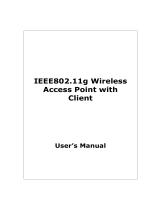
Contents
1 Introduction ······························································································ 5
1.1 Package Contents ·········································································· 5
1.2 Hardware installation steps ····························································· 6
1.3 The Front Panel ············································································· 7
1.4 The Rear Panel ·············································································· 8
2 Installation and Basic Configuration ···························································· 9
2.1 Operation Mode ············································································· 9
2.2 Connect This Router to Your Network ·············································· 9
2.3 Configure the IP Address of Your Computer ···································· 10
3 Web-Based Management ··········································································· 13
3.1 Start the Web-Based Management Interface ····································· 13
3.2 The Graphic User Interface ···························································· 14
3.3 Setup Wizard (Router mode and Client mode) ·································· 16
3.4 Wireless ······················································································· 17
3.4.1 Basic Settings ·············································································· 17
3.4.2 Advanced Settings ········································································ 19
3.4.3 Security ······················································································· 20
3.4.4 Access Control ············································································· 24
3.4.5 Wireless Site Survey (only in Client mode) ········································· 24
3.4.6 WPS Settings ··············································································· 25
3.5 TCP/IP Settings············································································· 27
3.5.1 LAN Interface Setup ······································································ 27
3.5.2 WAN Interface Setup (Router mode and Client mode) ·························· 28
3.6 Firewall Settings (Router mode and Client mode) ····························· 32
MAC Filtering ······················································································· 32
3.7 Management················································································· 33
3.7.1 Status ························································································· 33
3.7.2 Statistics ······················································································ 33
3.7.3 Log ···························································································· 34
3.7.4 Upgrade Firmware ········································································ 35
3.7.5 Save/Reload Setting ······································································ 36
3.7.6 Password ···················································································· 36
3.7.7 Logout ························································································ 37
Appendix A: Product Specifications ·································································· 38
Appendix B: Glossary ······················································································ 39























